Hadley Freeman's 10 awesome women: from Katharine Hepburn to Miss Piggy
They're funny and passionate. One of them can even rock a pastel pantsuit. Hadley Freeman hails her female heroes whose accomplishments deserve some serious respect
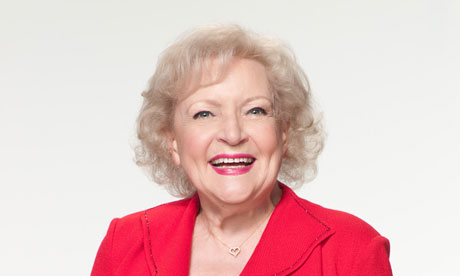
Betty White … more than geriatric self-mockery.
Betty White
These days, White is mainly known for two things: 1. Being old, and 2. Being funny about it. But there is so much more to her than geriatric self-mockery. Aside from her brilliant performances on The Golden Girls and The Mary Tyler Moore Show, White was one of the first women to take control of her own acting career by co-founding a TV production company in the 1950s. She was also nominated for the first best-actress Emmy in 1950, and her book about this period of her life, Here We Go Again: My Life in Television, is as funny as it is inspirational. Still sharp as a tack in her 10th decade, she is not only a hilarious actor but a hysterical off-the-cuff guest on American talk shows, always happy to share her political views.
"That is one crazy bitch," our Betty mused about Sarah Palin on the Late, Late Show with Craig Ferguson in 2008, casually swinging her pastel pantsuited legs about. Now, it is never nice to say such words about anyone but in the case of Palin I think White gets a free pass. And for the record, no one can rock a pastel pantsuit like Betty can.
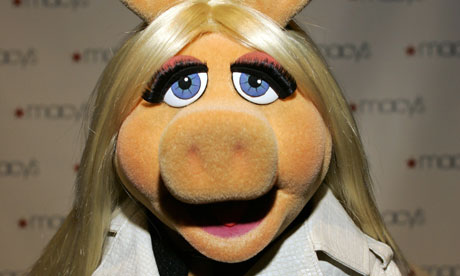 Miss Piggy … knows what she wants. Photograph: Rob Grabowski / Retna Ltd.
Miss Piggy … knows what she wants. Photograph: Rob Grabowski / Retna Ltd.Miss Piggy
Here is a woman – well, sow, really – who has a true sense of her self-worth. Despite being a TV and movie star, she has no self-defeating body insecurities or, for that matter, any insecurities whatsoever. She is damn good at what she does and she will be the first to tell you so. She is a strong, independent female yet not afraid to be vulnerable and to show that she has needs, fearlessly laying herself open to rejection again and again as she proclaims her love for her "Kermee". The idea that self-deprecation or modesty are necessary qualities in an attractive female is as anathema to her as a bacon sandwich, and yet she does not shun femininity; it's just that, with her, "femininity" means enjoying one's beauty and talents and taking it for granted that everyone else enjoys them too.
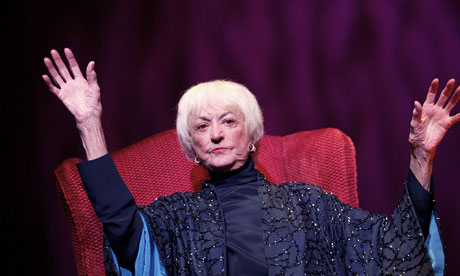 Bea Arthur … simply awesome. Photograph: Tristram Kenton
Bea Arthur … simply awesome. Photograph: Tristram KentonBea Arthur
Arthur was the star of two of the most radical sitcoms of all time, and it is an indictment of how social attitudes have gone backwards in America in the past few decades that neither of these programmes could be made now. As the eponymous Maude in the 1970s TV show, Arthur played a liberal feminist married woman who became the first woman on prime-time television to have an abortion (and two months before Roe v Wade, when abortion was legalised nationwide) because she and her husband simply don't want to have a baby. In The Golden Girls, Arthur, along with her fabulous three co-stars, played Floridian pensioners who have fun, have issues and, most of all, have sex. I can't remember the last time I saw someone on American TV over the age of 30 having sex.
Arthur was also a great friend to Rock Hudson when many others abandoned him out of homophobia. When someone once told Arthur that her height and deep voice made her a favourite among drag queens she replied: "I'm flattered." Bea Arthur was awesome.
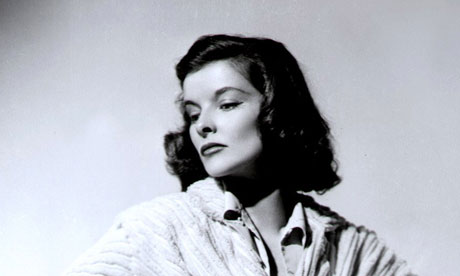 Katherine Hepburn … the human embodiment of 'glorious' Photograph: Sportsphoto Ltd/Allstar
Katherine Hepburn … the human embodiment of 'glorious' Photograph: Sportsphoto Ltd/AllstarKatharine Hepburn
The human embodiment of the word "glorious", Hepburn defied every social convention at the time. She always wore trousers, she refused to play ridiculous publicity games, she was a lifelong atheist and, having divorced her only husband after a youthful marriage, she vowed never to marry again, and instead spent her life secretly devoted to a married man, Spencer Tracy.
But without him, and after him, Hepburn was as defiant in her dotage as she had been in her youth. When she was 85, Warren Beatty and Annette Bening came to dinner, along with her friend and biographer A Scott Berg, who recorded the tale in Kate Remembered. After learning, to her astonishment, that Bening and Beatty were married, Hepburn muttered to Berg, "Poor girl." When Berg replied that they seemed very in love, Hepburn, "without missing a beat", replied, "With the same man."
She marched for woman's equality, supported Planned Parenthood and spoke out against McCarthyism at a time when such an act was near career suicide. Hepburn lived life with her chin jutted proudly upwards, defiant, uncompromising and courageous.
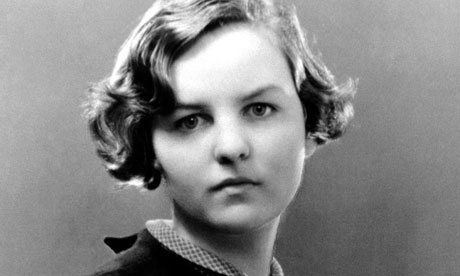 Decca Mitford … 'the most extraordinary of the Mitford sisters' Photograph: Empics
Decca Mitford … 'the most extraordinary of the Mitford sisters' Photograph: EmpicsDecca Mitford
In a highly competitive field, Decca has always struck me as the most extraordinary of the Mitford sisters. In a somewhat less competitive field, she is also the most admirable. The second-youngest of the siblings, even as a child Decca renounced the very thing that still entrances so many people today about her family: their world of privilege. She saved pennies throughout her childhood so as to be able to run away from home as soon as possible. Which, age 19, she did, with her even more militantly socialist cousin Esmond Romilly and the two lived in Spain, London and then America, passionately in love.
Rejecting the rightwing and fascist politics of her class in general and her family in particular, Mitford became a lifelong socialist and, for some time, a member of the Communist party in America, right in the thick of the McCarthy era.
After Romilly died, she married Bob Treuhaft. Together, they vigorously and courageously fought for civil rights and social justice in America, and Mitford became an acclaimed investigative journalist. Her book The American Way of Death might not have the sparkle of Nancy's novels but Decca was never interested in sparkle: instead, she wrote a sober, groundbreaking and still relevant study on, of all things, the funeral industry.
Yet despite her vociferous disgust for the fascist politics of her sisters Unity, Diana and, for a brief spell, Nancy, she never stopped loving them and exchanged fond correspondence with them, as is right. Principles and morality were Mitford's bywords but she never denied where she came from and she always knew she was, in the purest sense, a Mitford sister.
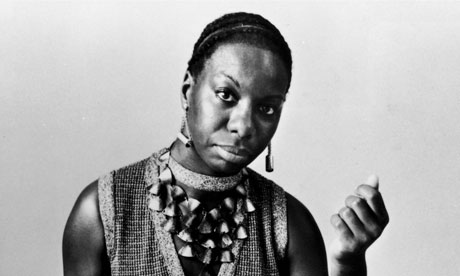 Nina Simone … passionate. Photograph: Getty Images
Nina Simone … passionate. Photograph: Getty ImagesNina Simone
Oh, she was a pistol, the woman born Eunice Kathleen Waymon. Belligerent, temperamental to the point that she was later diagnosed as bipolar, a notoriously unpredictable live performer and when asked in a 1999 interview whether the rumour about her pulling a gun on a record company boss who refused to pay her royalties was true, she replied: "I sure damn did!" The reporter suggested that "men are going to be a bit nervous of you". She didn't even let him finish: "They are, very. But I refuse to cook or to clean. They've got to take me as I am and recognise that I'm a star as well as a woman and they have to deal with the two."
Many think that much of Simone's anger had its roots in professional frustration. Despite her enormous success, Simone had wanted to be a classical musician. But in 1950s America, the easiest and maybe even the only path open to a young black woman who wanted to make her living out of music was the one marked blues and jazz.
This was perhaps the one time Simone compromised. She refused to be confined by her race or gender and her music crossed the divides of both. In her wonderful autobiography, I Put a Spell on You, she emphasises that taking a stand is not just the business of men: "It was always Marx, Lenin and revolution – real girls' talk."
She was a passionate civil rights activist and her music became the soundtrack of the movement. She was utterly fearless, introducing her song Mississippi Goddamn, about the murder of Medgar Evers, with the proclamation: "And I mean every word of it." As if there could be any doubt.
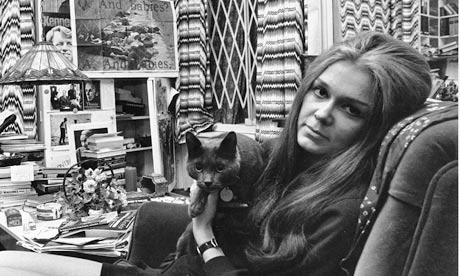 Gloria Steinem and her cat in 1970. Photograph: AP
Gloria Steinem and her cat in 1970. Photograph: APGloria Steinem
There are dozens of reasons to admire Gloria Steinem: the face of women's rights and the pro-choice movement for half a century, Steinem testified in the Senate on behalf of the Equal Rights Amendment, co-founded the Women's Action Alliance and remains, now well into her 70s, a tireless campaigner on behalf of women's rights. Unlike her contemporary Betty Friedan, Steinem is a big supporter of gay rights and equality; unlike Germaine Greer, she has never appeared on a reality TV programme alongside Sylvester Stallone's ex-wife. Steinem, thankfully, has no time for the tedious academic theorising that bogs down so much feminist discourse but favours instead plain speaking, good humour and common sense. In response to the critics who yelped when Steinem, at 66, married environmentalist David Bale, she pointed out that the institution of marriage had changed enormously since she spoke against it in the 1970s. Bale then travelled around the country with her while she gave speeches, proving the model of a modern husband before his death only three years after they married. Steinem is indefatigable and inspirational.
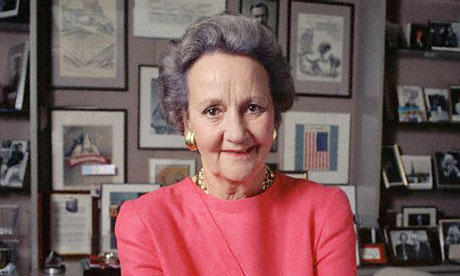 Katherine Graham … brave. Photograph: Wally Mcnamee
Katherine Graham … brave. Photograph: Wally McnameeKatharine Graham
Some people would have serious qualms about becoming the publisher of a major national newspaper, especially when they have had next to no experience and there are no other people of their gender in a similar position. Almost everyone, surely, would prefer to live out their days in peaceful equanimity if they had recently come through a heartbreakingly difficult marriage, during which their spouse suffered from alcoholism and psychiatric problems. That is not what Katharine Graham did. After her husband, Philip, killed himself in 1963 she stepped in and took over his position as the publisher of the Washington Post. Graham helmed the Post through its most exciting, high-profile and risky period, when it covered the Watergate scandal, standing unwaveringly behind the reporters who uncovered it, Carl Bernstein and Bob Woodward, and the paper's editor, Ben Bradlee.
In her clear-sighted and unsentimental Pulitzer prizewinning autobiography, Personal History, Graham writes about the events of that time but the real story of the book is how a woman whose confidence had been destroyed built herself back up by finding her purpose in work and becoming, in turn, a legendary figure in American journalism.
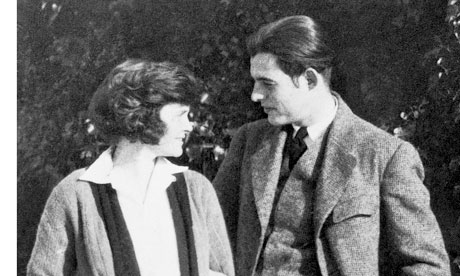 Hadley Richardson with Ernest Hemingway. Photograph: AP
Hadley Richardson with Ernest Hemingway. Photograph: APHadley Richardson
My namesake and – perhaps more famously – Ernest Hemingway's first wife, therefore the only one who married him when he was unknown and humble as opposed to famous and arrogant.
Richardson was, by all accounts, quiet and kind, and recorded interviews reveal her to have had a cheeky sense of humour and a warm and ready laugh. She was also, judging from the photos of her, fond of culottes, and I approve of that.
The young couple moved to Paris and she was unimpressed by the famous people they met there – the Fitzgeralds, Gertrude Stein, Gerald and Sara Murphy – and these fame-dazzled narcissists were similarly not taken with her, dismissing her as dull and unworthy. Under the guidance of his tedious friends, Hemingway ditched his young wife and son at the first lick of a literary triumph.
But it was Richardson who had the better life, enjoying a contented marriage with the first winner of the Pulitzer prize. Hemingway realised his mistake too late, writing of Richardson in A Movable Feast: "I wished I had died before I loved anyone but her." Richardson was unencumbered with any such regrets. When a journalist asked if she missed her famous friends and glamorous Parisian life she replied: "No. I think I wanted something real."
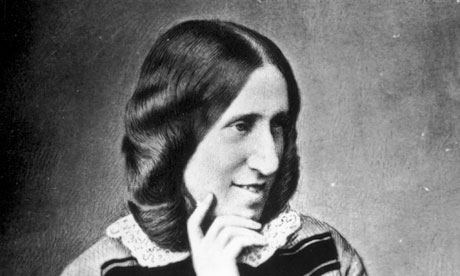 George Eliot … brilliant. Photograph: Hulton Getty
George Eliot … brilliant. Photograph: Hulton GettyGeorge Eliot
Middlemarch aside, it has taken me a while to come round to George Eliot's novels. This is probably because I made the egregious error of starting with Daniel Deronda, her last novel and, by some measure, her dreariest. I spent more time studying the fascinating portrait of Eliot on the back of the book than I did reading the wretched thing: that thoughtful face, so endearingly plain with just a hint of a smile, gave a hint of her true nature. Namely, that Eliot was one of the sauciest and smartest women in the 19th century.
To the sauce first. Eliot fell in love with the married critic George Henry Lewes when she was 32, a hopeless spinster by the standards of the day. For the rest of Lewes's life, they openly had a relationship while he stayed married to his wife, and Eliot dedicated The Mill on the Floss to "my beloved husband, George Henry Lewes". Four years after Lewes died, the novelist, at the age of 60, embarked on a relationship even more scandalous when she married John Cross, 20 years younger than herself.
As for the smarts, Eliot was brilliant. Aside from her novels, all of which engaged in political issues of the day, she did translations, wrote philosophical essays and reviews. She was a woman who refused to be bound by the conventions of the day, doing the work she wanted and living with the men she wanted when few women could do either. She wrote novels for the mind and pursued love from the heart. That is a life well lived.
© Hadley Freeman 2013
This is an edited extract from Be Awesome, by Hadley Freeman, published next week by Fourth Estate at £12.99. To order a copy for £9.99, including free UK p&p, go to guardian.co.uk/bookshop, or call 0330 333 56846.
No comments:
Post a Comment